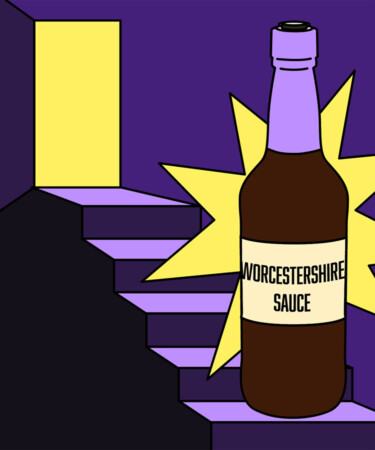This article is part of our Cocktail Chatter series, where we dive into the wild, weird, and wondrous corners of history to share over a cocktail and impress your friends.
Whether or not you can pronounce it right, Worcestershire sauce is a pantry staple. Beloved for its tangy, umami-loaded flavor profile, the sauce can usually be found alongside similar fermented condiments including fish sauce, gochujang, and ketchup. It was conceived with the intention of adding a bit of zing to dishes, many of them classics including Welsh rarebit, shepherd’s pie, and beef stew. It’s even dynamic in cocktails, like the Bloody Mary. But as for how the version of the sauce you’ll find on shelves today came to be? That was an accident.
In 1823, merchants John Wheeley Lea and William Henry Perrins opened Lea & Perrins, a drug store along the River Severn in Worcester, England. Located approximately halfway between the major ports of Bristol and Birmingham, the shop offered food, household products, medicine, and an assortment of products from all over the world that made their way into the shop via the ports. The story goes that one day in the 1830s, Lord Sandys, a former governor of Bengal, wandered into the drug store and requested the two operators make a sauce based on a recipe he had discovered while staying in India. Using the worldly ingredients Lea and Perrins had at their disposal, they made two batches of the sauce — one for Lord Sandys, and one for themselves. But after tasting the sauce they made for themselves, both Lea and Perrins found it foul-tasting, and stashed it in their store’s cellar. Approximately 18 months later, the sauce was rediscovered by a Lea & Perrins employee who realized it had developed into something else entirely: It was sweet yet salty, peppery yet acidic. It was absolutely delicious, and destined to be a hit.
Lea & Perrins released its Worcestershire sauce commercially in 1837. It was instantly beloved for both its flavor and its durability, as it didn’t even need to be refrigerated. Due to the store’s proximity to two of England’s major ports, it became extremely popular among sailors and stewards who brought bottles aboard their ships to improve the bland foods made to survive weeks at sea. By 1843, Lea & Perrins was selling approximately 15,000 bottles of Worcestershire sauce per year, and by 1849, shipments were being delivered as far away as San Francisco.
Given the sauce’s popularity, it wasn’t long before other companies started mimicking the condiment’s flavor profile, which pushed Lea & Perrins to obtain a court ruling in 1906 that allowed them to label their product “Original and Genuine.” Even now, every bottle of Lea & Perrins comes equipped with a label declaring it “The Original Worcestershire Sauce.”
While the Lea & Perrins drug store no longer exists, the sauce itself is now owned by Kraft Heinz, and its exact recipe remains a closely guarded secret. The only ingredients the sauce is confirmed to contain include white vinegar, molasses, sugar, water, salt, onions, anchovies, garlic, cloves, tamarind, and chili pepper extract, though their exact proportions and the recipe’s additional ingredients remain a mystery.
This secrecy has not stopped others from attempting to make a Worcestershire of their own, though it’s unlikely any could ever top Lea & Perrins. Every year, approximately 25 million bottles of the sauce are made and shipped all over the globe, and our Bloodys are better for it.
*Image retrieved from dbvirago via stock.adobe.com
